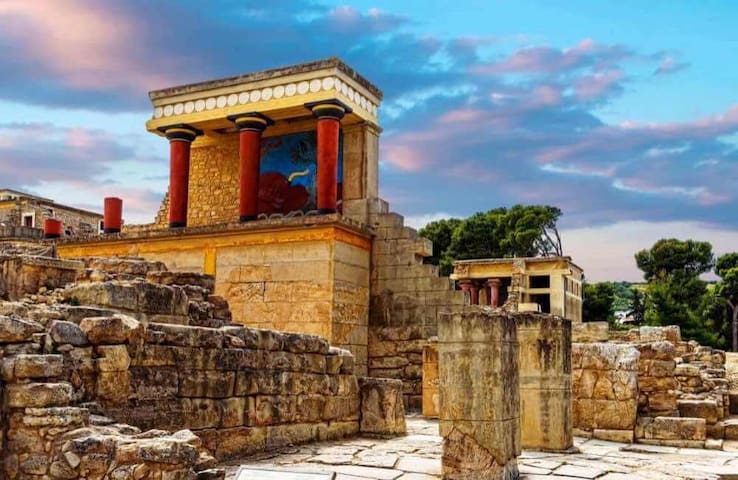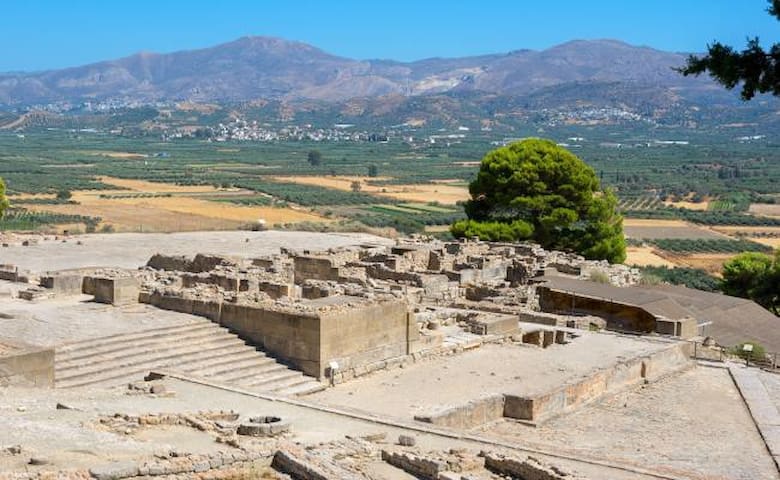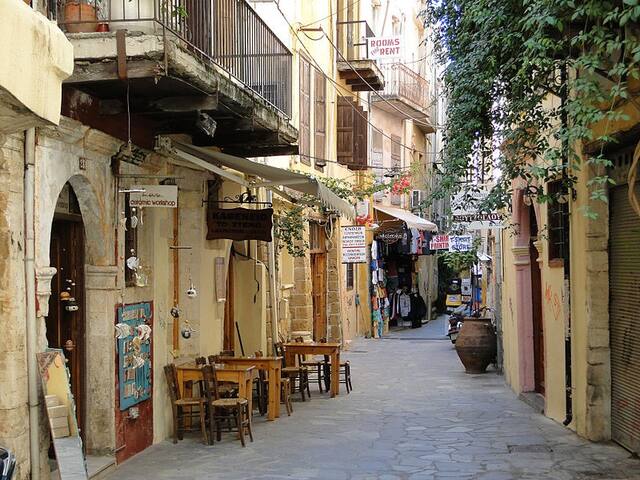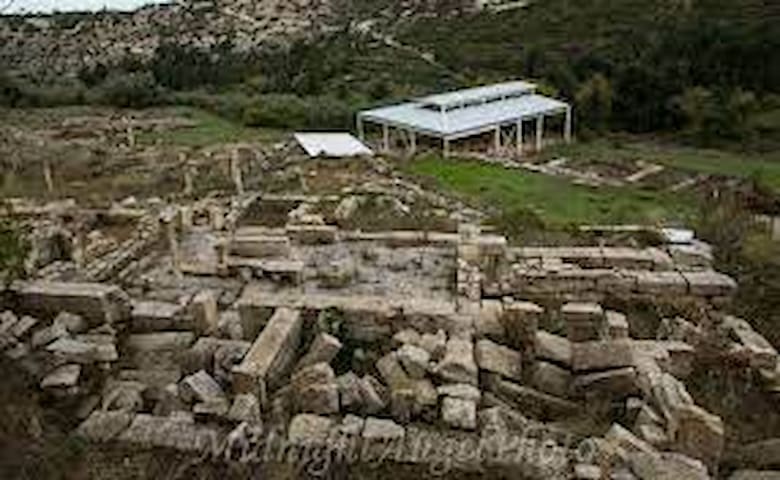The most popular Historic Spots in Crete
The Fortezza (Greek: Φορτέτζα, from Italian for "fortress") is the citadel of the city of Rethymno in Crete, Greece. It was built by the Venetians in the 16th century and was captured by the Ottomans in 1646. By the early 20th century, many houses were built within the citadel. These were demolished after World War II, leaving only a few historic buildings within the Fortezza. Today, the citadel is in good condition and is open to the public.
In the summertime, there are many festivals and theatrical performances at the castle with very cheap tickets
541 paikallista suosittelee
Fortezzan linna
The Fortezza (Greek: Φορτέτζα, from Italian for "fortress") is the citadel of the city of Rethymno in Crete, Greece. It was built by the Venetians in the 16th century and was captured by the Ottomans in 1646. By the early 20th century, many houses were built within the citadel. These were demolished after World War II, leaving only a few historic buildings within the Fortezza. Today, the citadel is in good condition and is open to the public.
In the summertime, there are many festivals and theatrical performances at the castle with very cheap tickets
The Arkadi Monastery (in Greek: / Μονή Αρκαδίου) is an Eastern Orthodox monastery, situated on a fertile plateau 23 km (14 mi) to the southeast of Rethymnon on the island of Crete in Greece.
The current catholicon (church) dates back to the 16th century and is marked by the influence of the Renaissance. This influence is visible in the architecture, which mixes both Roman and baroque elements. As early as the 16th century, the monastery was a place for science and art and had a school and a rich library. Situated on a plateau, the monastery is well fortified, being surrounded by a thick and high wall.
The monastery played an active role in the Cretan resistance of Ottoman rule during the Cretan revolt of 1866. 943 Greeks, mostly women and children, sought refuge in the monastery. After three days of battle and under orders from the hegumen (abbot) of the monastery, the Cretans blew up barrels of gunpowder, choosing to sacrifice themselves rather than surrender.
The monastery became a national sanctuary in honor of the Cretan resistance. 8 November is a day of commemorative parties in Arkadi and Rethymno. The explosion did not end the Cretan insurrection, but it attracted the attention of the rest of the world.
178 paikallista suosittelee
Arkadin luostari
The Arkadi Monastery (in Greek: / Μονή Αρκαδίου) is an Eastern Orthodox monastery, situated on a fertile plateau 23 km (14 mi) to the southeast of Rethymnon on the island of Crete in Greece.
The current catholicon (church) dates back to the 16th century and is marked by the influence of the Renaissance. This influence is visible in the architecture, which mixes both Roman and baroque elements. As early as the 16th century, the monastery was a place for science and art and had a school and a rich library. Situated on a plateau, the monastery is well fortified, being surrounded by a thick and high wall.
The monastery played an active role in the Cretan resistance of Ottoman rule during the Cretan revolt of 1866. 943 Greeks, mostly women and children, sought refuge in the monastery. After three days of battle and under orders from the hegumen (abbot) of the monastery, the Cretans blew up barrels of gunpowder, choosing to sacrifice themselves rather than surrender.
The monastery became a national sanctuary in honor of the Cretan resistance. 8 November is a day of commemorative parties in Arkadi and Rethymno. The explosion did not end the Cretan insurrection, but it attracted the attention of the rest of the world.
Knossos ( Ancient Greek: Κνωσός) is the largest Bronze Age archaeological site on Crete and has been called Europe's oldest city.
Settled as early as the Neolithic period, the name Knossos survives from ancient Greek references to the major city of Crete. The palace of Knossos eventually became the ceremonial and political centre of the Minoan civilization and culture. The palace was abandoned at some unknown time at the end of the Late Bronze Age, c. 1380–1100 BC; the reason is unknown, but one of the many disasters that befell the palace is generally put forward.
In the First Palace Period (around 2000 BC), the urban area reached a size of as many as 18,000 people. In its peak, the palace and surrounding city boasted a population of 100,000 people shortly after 1700 BC
407 paikallista suosittelee
Knossos
Knossos ( Ancient Greek: Κνωσός) is the largest Bronze Age archaeological site on Crete and has been called Europe's oldest city.
Settled as early as the Neolithic period, the name Knossos survives from ancient Greek references to the major city of Crete. The palace of Knossos eventually became the ceremonial and political centre of the Minoan civilization and culture. The palace was abandoned at some unknown time at the end of the Late Bronze Age, c. 1380–1100 BC; the reason is unknown, but one of the many disasters that befell the palace is generally put forward.
In the First Palace Period (around 2000 BC), the urban area reached a size of as many as 18,000 people. In its peak, the palace and surrounding city boasted a population of 100,000 people shortly after 1700 BC
Faistos ( Greek : Φαιστός ) also transliterated as Phaistos , Phaestos , Festos or Phaestus , was an ancient Minoan city on the island of Crete .
It is located in the south of the central part of the island, about 5.6 km from the Mediterranean coast . The oldest evidence of its occupation dates from the 4th millennium BC
A few kilometers southwest of Faist there is another archeological site from the Minoan period - the Hagia Triada Palace .
It is also a municipality in the regional unit of Heraklion .
91 paikallista suosittelee
Faistos
Faistos ( Greek : Φαιστός ) also transliterated as Phaistos , Phaestos , Festos or Phaestus , was an ancient Minoan city on the island of Crete .
It is located in the south of the central part of the island, about 5.6 km from the Mediterranean coast . The oldest evidence of its occupation dates from the 4th millennium BC
A few kilometers southwest of Faist there is another archeological site from the Minoan period - the Hagia Triada Palace .
It is also a municipality in the regional unit of Heraklion .
You can explore the roads of our old town and the historic cafes and shops
73 paikallista suosittelee
Old Town
36 Emmanoil VernardoyYou can explore the roads of our old town and the historic cafes and shops
The old (Venetian) harbour of Rethymno, which also lies in the heart of the harbour facilities . The Egyptian lighthouse overlooks the entrance to the harbour. The fishing boats and the yachts dock alongside the Venetian harbour where fish- restaurants are open during the summer months.
270 paikallista suosittelee
Vanha venetsialainen satama
The old (Venetian) harbour of Rethymno, which also lies in the heart of the harbour facilities . The Egyptian lighthouse overlooks the entrance to the harbour. The fishing boats and the yachts dock alongside the Venetian harbour where fish- restaurants are open during the summer months.
Those walking boots will get a good workout during this hike through the Samaria Gorge. This 16km-long ravine is the longest in Europe. So it's a serious – but spectacular – five to six-hour trek that's not for the unfit or faint-hearted.
You'll start by driving through the White Mountains to your starting point – the Xyloskalo staircase, which zigzags some 200 metres down into the gorge. You'll pass tiny chapels, walk between the high ravine walls and maybe spot some of Crete's wild ‘kri-kri' goats. The highlight though, is the ‘Iron Gates' – the narrowest section of the gorge where the 300-metre-high walls stand just 3 metres apart.
At the end, you'll reach the seaside village of Agia Roumeli, where if you've made good time, you can take a swim or relax in a taverna. Then, when everyone's ready, you'll catch a boat along the coast to where your coach awaits. Great for outdoor types.
517 paikallista suosittelee
Samaria Gorge
Those walking boots will get a good workout during this hike through the Samaria Gorge. This 16km-long ravine is the longest in Europe. So it's a serious – but spectacular – five to six-hour trek that's not for the unfit or faint-hearted.
You'll start by driving through the White Mountains to your starting point – the Xyloskalo staircase, which zigzags some 200 metres down into the gorge. You'll pass tiny chapels, walk between the high ravine walls and maybe spot some of Crete's wild ‘kri-kri' goats. The highlight though, is the ‘Iron Gates' – the narrowest section of the gorge where the 300-metre-high walls stand just 3 metres apart.
At the end, you'll reach the seaside village of Agia Roumeli, where if you've made good time, you can take a swim or relax in a taverna. Then, when everyone's ready, you'll catch a boat along the coast to where your coach awaits. Great for outdoor types.
Eleutherna (Greek: Ἐλεύθερνα), also called Apollonia (Greek: Ἀπολλωνία), was an ancient city-state in Crete, Greece, which lies 25 km southeast of Rethymno in Rethymno regional unit. Archaeologists excavated the site, located on a narrow northern spur of Mount Ida, the highest mountain in Crete. The site is about 1 km south of modern town of Eleftherna, about 8 km north east of Moni Arkadiou, in the current municipality of Rethymno. It flourished from the Dark Ages of Greece’s early history until Byzantine times.
144 paikallista suosittelee
Eleutherna
Eleutherna (Greek: Ἐλεύθερνα), also called Apollonia (Greek: Ἀπολλωνία), was an ancient city-state in Crete, Greece, which lies 25 km southeast of Rethymno in Rethymno regional unit. Archaeologists excavated the site, located on a narrow northern spur of Mount Ida, the highest mountain in Crete. The site is about 1 km south of modern town of Eleftherna, about 8 km north east of Moni Arkadiou, in the current municipality of Rethymno. It flourished from the Dark Ages of Greece’s early history until Byzantine times.




